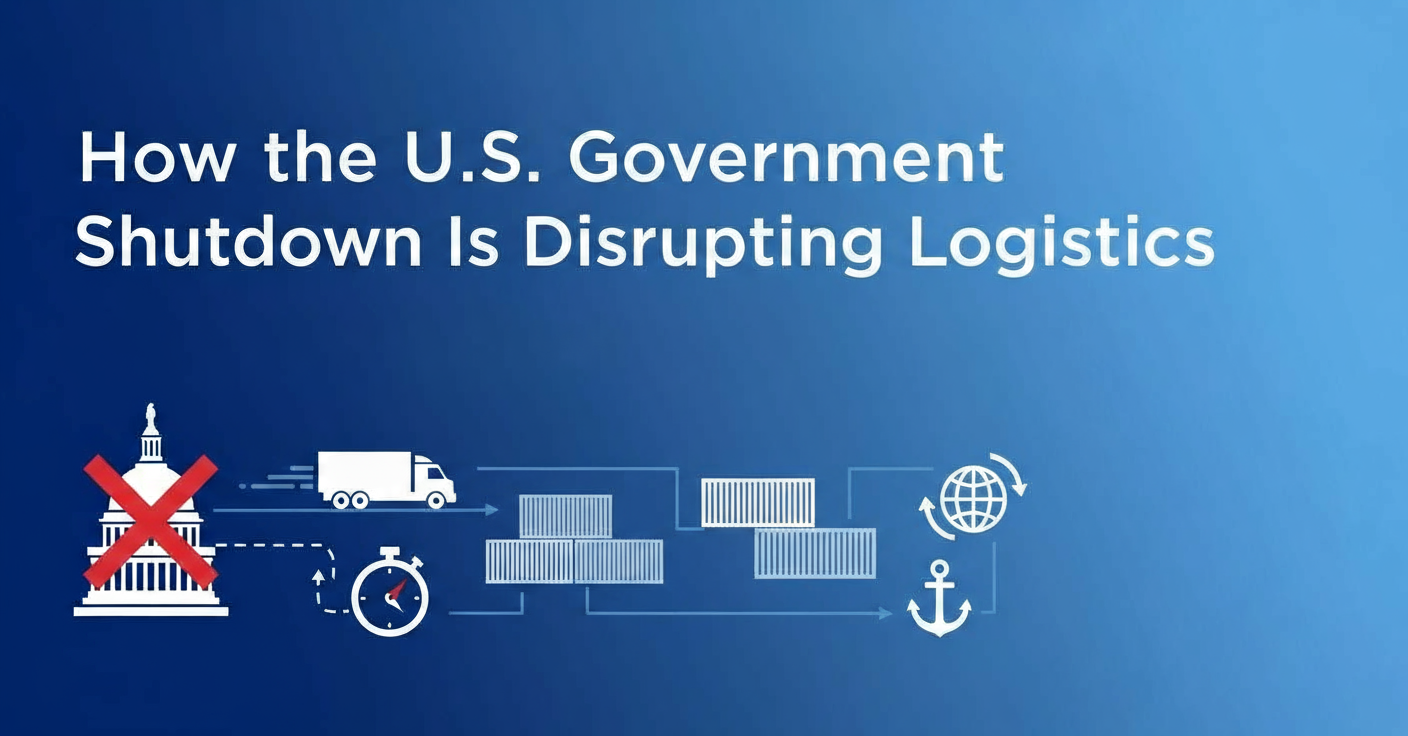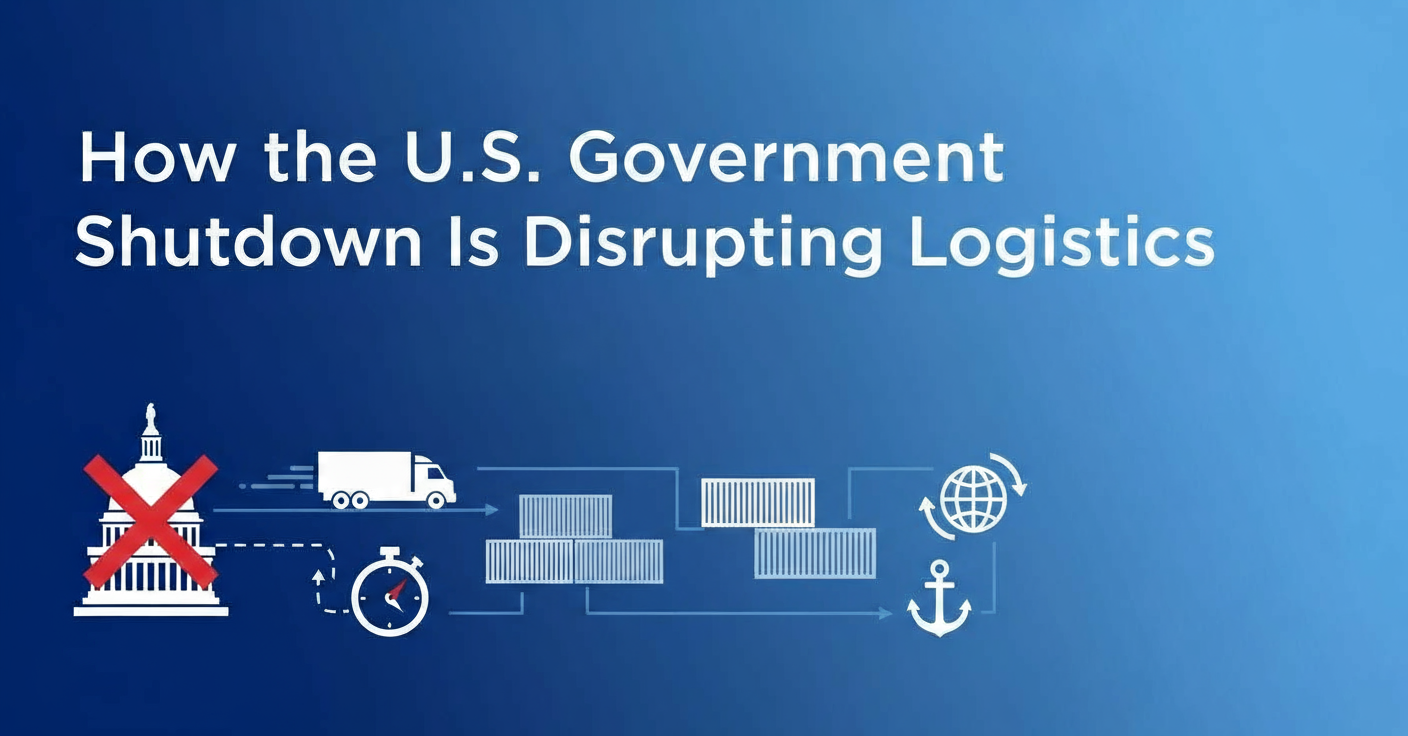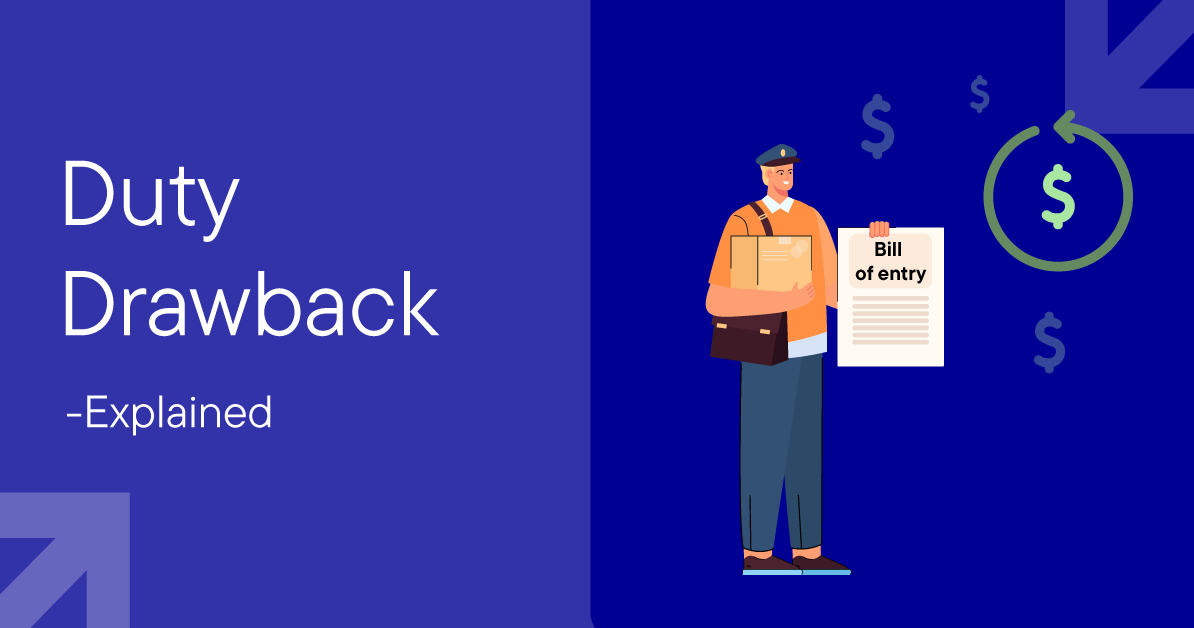How the U.S. Government Shutdown Is Disrupting Logistics (And What You Need to Know)


Here we go again. As of October 1, 2025, the U.S. government has officially shut down after Congress failed to pass a funding bill.
And while politicians argue in Washington, the logistics industry is already feeling the pain.
If you're moving freight, managing a warehouse, or trying to get shipments through customs, you need to know what's happening right now.
The good news? Cargo is still moving.
The bad news? It's getting slower, more expensive, and a lot more complicated.
Let's break down what's actually going on and how it affects your operations.
What's Actually Happening at Ports and Customs?
CBP is operational, but running lean. Which means, customs officers continue processing cargo but thousands of support staff are furloughed. That means:
- Documentation takes longer
- Inspections get backed up
- Clearance times stretch out
And if you're importing perishables, pharmaceuticals, or anything that needs quick turnaround?
You're in the high-risk zone.
Partner Government Agencies are the real bottleneck. This is where things get messy. Agencies like the FDA, USDA, and EPA are running with skeleton crews or not running at all.
If your shipment needs review from any of these agencies, expect delays. We're talking 24 to 72 extra hours for FDA and USDA-related entries, especially for food, cosmetics, and pharmaceuticals.

Air Cargo: TSA Staff Working Without Pay
Air cargo screening is still happening, but TSA staff aren't getting paychecks. During the 2018-2019 shutdown, unpaid TSA workers started calling in sick, which led to longer lines and major delays.
Morale is already a concern, and if the shutdown drags on, absenteeism could spike. Freight forwarders using air cargo should be planning for potential slowdowns at major hubs like Memphis and Louisville.
Air Traffic Control Crisis Deepening
The situation in the skies is getting worse. Transportation Secretary Sean Duffy confirmed that the air traffic control system is critically understaffed, needing 2,000 to 3,000 more controllers.
With existing controllers working without pay, even a few calling in sick creates a "ricochet through the air space" that leads to cascading delays.
Duffy issued a stark warning: "We will slow you down. We will cancel flights. We want to make sure that when you travel, you travel safely."
What this means for air cargo:
- Expect increased flight cancellations, not just delays
- Major cargo hubs are at highest risk for disruptions
- Plan for alternative routing options now, not when delays hit
Trucking: New Drivers? Good Luck With That
If your trucking company is trying to onboard new drivers, you're stuck. Background checks, compliance reviews, and permitting are all paused. That means no new hires until the government reopens.
For cross-border operations, customs bottlenecks at the U.S.-Mexico and U.S.-Canada borders are creating ripple effects that slow down rail and truck shipments.
Export Licensing? Basically Frozen
Here's a big one that's flying under the radar: the Bureau of Industry and Security (BIS) has stopped processing most export licenses. Unless your license is tied to national security, it's not getting reviewed.
Antidumping and countervailing duty cases? Also paused.
Deadlines will be extended until the government reopens, but if you're counting on a ruling to move forward with a deal, you're in limbo.
Federal Agencies Hit the Hardest
The ongoing federal shutdown has severely disrupted government operations, with some agencies nearly at a standstill.
- Federal Maritime Commission: 94% of staff furloughed—no new filings, service contracts, or tariff registrations for ocean shipping.
- Surface Transportation Board: 99% furloughed—rail competition cases, regulatory filings, and litigation suspended.
- Environmental Protection Agency (EPA): 93% furloughed—environmental permits for freight and infrastructure projects are on hold.
In contrast, agencies funded by the Highway Trust Fund, such as the FMCSA and FHWA, remain operational—providing a small measure of stability for transportation and logistics.
The human toll is significant. About 1.4 million federal employees are either suspended or working without pay, with more than 4,000 workers already terminated, including most of the Department of Education’s special education staff.
Even essential operations are strained; the Pentagon recently diverted $8 billion from research to ensure military pay continues—an indicator that the shutdown could drag on.
For logistics operators, the consequences are immediate and widespread:
- Fewer staff available to process paperwork at every federal touchpoint
- Longer wait times as limited crews manage normal workloads
- Higher risk of administrative errors and delays in clearances
Warehouses and Retailers: The Whiplash Effect
Here's a problem that doesn't get enough attention: warehouses are caught in the middle.
When ports slow down, cargo inflow drops. Warehouses sit underutilized. Then, when the backlog clears, there's a sudden surge. Facilities get overwhelmed. Labor scheduling becomes a nightmare.
If you're working with retailers who have strict delivery windows, this is where costs start piling up. Missing a delivery slot because of port delays can mean penalties, chargebacks, or lost contracts.
How Long Will This Last?
Nobody knows. The last shutdown in 2018-2019 lasted 35 days—the longest in U.S. history. This one is tied to a budget standoff between Republicans and Democrats, with neither side showing signs of compromise.
Markets are already reacting. Stock futures dipped. The dollar weakened. Gold prices hit record highs. Analysts are warning that the longer this drags on, the worse it gets for logistics and the broader economy.
What Should You Do Right Now?
If you're in logistics, here's your action plan:
1. Build in extra time. Assume delays at ports, borders, and for any shipments requiring FDA, USDA, or EPA review. Add 24-72 hours to your timelines for perishables and regulated goods.
2. Communicate with customers early. Don't wait until a shipment is late to let them know. Set expectations now about potential delays.
3. Strengthen internal compliance. With fewer federal inspections happening, you're the first line of defense. Keep detailed records of all safety checks and compliance measures.
4. Monitor agency updates. Check CBP, FDA, and USDA websites regularly for real-time updates on operations and processing times.
5. Plan for post-shutdown enforcement. When agencies come back to full capacity, they often ramp up inspections and audits. Don't let compliance slip during the shutdown, or you could face penalties later.
6. Work closely with customs brokers. They're your best source for real-time information on what's happening at specific ports and border crossings.
7. Diversify your supply chain if possible. If you're heavily reliant on a single port or border crossing, consider alternative routes to spread risk.
8. Prepare for the long haul. With the shutdown entering week three and no compromise in sight, don't plan for a quick resolution. The last major shutdown lasted 35 days. Build contingency plans assuming at least that timeline, if not longer.
The Bigger Picture
Here's the thing: even short government shutdowns have long tails. A week of delays doesn't just disappear when funding resumes. It creates backlogs that take weeks or months to clear.
And every day this shutdown continues, the ripple effects get worse. Port congestion leads to container shortages.
Container shortages drive up freight rates. Higher freight rates squeeze margins. Squeezed margins force tough decisions.
For now, cargo is still moving, planes are still flying, and trains are still running. But each day the shutdown continues adds more delays, more costs, and more uncertainty across the entire supply chain.
Stay Informed
The situation is fluid, and things can change quickly. If you're dealing with international shipments, keep an eye on CSMS notices from CBP and check with your freight forwarder regularly.
Need help navigating the shutdown? Work with experienced international freight forwarder who can adapt to changing conditions and keep your freight moving even when the government can't keep its doors open.
Frequently Asked Questions
Why did this government shutdown happen?
The shutdown happened because Congress failed to pass a funding bill before the September 30 deadline. The standoff is between Republicans, who want a temporary extension of spending, and Democrats, who are demanding that health care subsidies be included in the bill. Neither side has signaled compromise yet.
As of now, Republicans have secured three Democratic votes for their spending bill but need five more (or four if Senator Rand Paul, the one Republican who voted against it, changes his vote). Unfortunately, bipartisan cooperation seems to be getting rarer, so there's no telling how long it'll take to reach a deal.
Will my shipment still clear customs during the shutdown?
Yes, but it'll likely take longer. Customs and Border Protection officers are still processing cargo at all ports of entry. However, with thousands of support staff furloughed, documentation and inspections are slower. If your shipment requires review from Partner Government Agencies like the FDA, USDA, or EPA, expect additional delays of 24-72 hours or more.
Are food imports and exports affected?
Absolutely. While USDA inspectors are still conducting daily inspections at meat, poultry, and egg facilities (because it's legally required), export certifications are slowing down.
FDA is operating at reduced capacity, which means longer clearance times for imported food, pharmaceuticals, and cosmetics. Perishable goods face the highest risk of spoilage due to extended wait times.
Can I still file for export licenses?
Not really. The Bureau of Industry and Security (BIS) has suspended most export license processing. Only emergency licenses tied to national security are being reviewed right now. If you're waiting on a license for commercial exports, you'll need to wait until the government reopens.
Will freight rates go up because of the shutdown?
Possibly. If port congestion worsens and dwell times increase significantly, it can tie up containers and reduce shipping capacity. When capacity tightens, freight rates tend to rise. We saw this pattern during the 2018-2019 shutdown, and similar pressure is building now.





